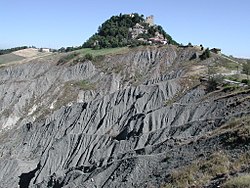Canossa
| Canossa | ||
|---|---|---|
| Comune | ||
| Comune di Canossa | ||

View of the Rock of Canossa with the ruins of the castle visible at the top
|
||
|
||
| Location of Canossa in Italy | ||
| Coordinates: 44°36′N 10°25′E / 44.600°N 10.417°E | ||
| Country | Italy | |
| Region | Emilia-Romagna | |
| Province / Metropolitan city | Reggio Emilia (RE) | |
| Frazioni | Albareto, Borzano Chiesa, Borzano di Sopra, Borzano di Sotto, Braglie, Casalino, Cavandola, Ceredolo de' Coppi, Ceredolo dei Coppi Nuovo, Cerezzola, Ciano d'Enza, Compiano, Crognolo, Currada, Dirotte, Fornace, Gazzolo, Iagarone, Massalica, Monchio delle Olle, Pietranera, Roncaglio, Roncovetro, Rossena, Selva, Selvapiana, Solara, Trinità, Vedriano, Verlano, Votigno | |
| Government | ||
| • Mayor | Enzo Musi | |
| Area | ||
| • Total | 53 km2 (20 sq mi) | |
| Highest elevation | 689 m (2,260 ft) | |
| Lowest elevation | 112 m (367 ft) | |
| Population (31 December 2014) | ||
| • Total | 3,854 | |
| • Density | 73/km2 (190/sq mi) | |
| Demonym(s) | Canossani | |
| Time zone | CET (UTC+1) | |
| • Summer (DST) | CEST (UTC+2) | |
| Postal code | 42263 | |
| Dialing code | 0522 | |
| Website | Official website | |
Canossa is a comune and castle town in the Province of Reggio Emilia, Emilia-Romagna, northern Italy. It is the site where Holy Roman Emperor Henry IV did penance in 1077, standing three days bare-headed in the snow, in order to reverse his excommunication by Pope Gregory VII. The Walk to Canossa is sometimes used as a symbol of the changing relationship between the medieval Church and State.
As of December 2014[update], Canossa has a population of 3,854, and borders the comuni of Casina, Castelnovo ne' Monti, Neviano degli Arduini (PR), San Polo d'Enza, Traversetolo (PR), Vetto, and Vezzano sul Crostolo.
The town was formerly known as Ciano d'Enza, while Canossa was the name of only the castle, now in ruins, once belonging to Matilda of Tuscany, and nearby hamlet, which lie some 8 km east of the town. The new name was decided in 1992.
Canossa Castle was built before the middle of the 10th century by Adalbert Atto, son of Sigifred of Lucca.
Adelaide of Italy, in the 10th century the daughter, daughter-in-law, and widow in turn of three kings, was hard pressed by a local nobleman, Berengar of Ivrea, who declared himself king of Italy, abducted Adelaide, and tried to legitimize his reign by forcing Adelaide to marry his son Adalbert; but she escaped to Canossa. From the rocca of Canossa she called for German intervention. Canossa was inherited by Matilda of Tuscany, the principal Italian supporter of Pope Gregory VII, in 1052.
...
Wikipedia


